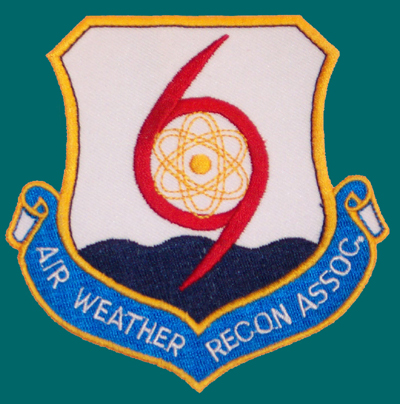
WB-66D
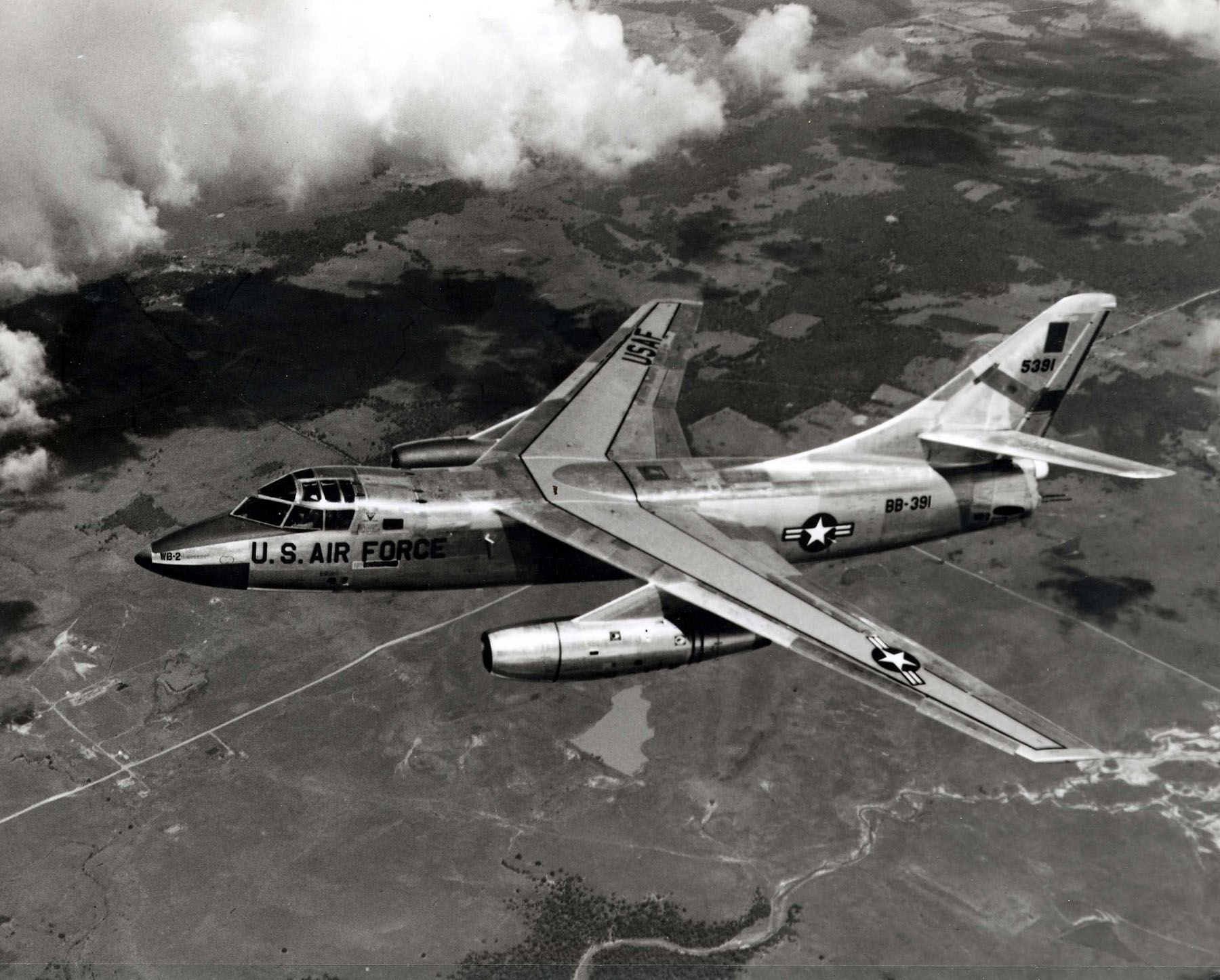 |
| Official
USAF Photo/Illustration, Courtesy of National Museum of the USAF |
| Beginning
this month, we will post a series of articles on the various aircraft
and units of weather reconnaissance and atmospheric sampling. I
hope to add one aircraft type and one unit per month. The aircraft
topic for Feb is the weather reconnaissance version of the B-66
Destroyer, the WB-66D. The WB-66D aircraft was not used by
AWS-owned units, but did play a major role in the development weather
gathering systems that would be fielded on the
WB-47E and the WC-135B. |
| These
are not the first aircraft specific posts that we've had on the AWRA
web site. That honor goes to our WB-57 article from Oct-Nov
2004 (which we will update soon, I hope) and Tom Robison's great
article about the WC-130 - or "Whiskey Charlie". |
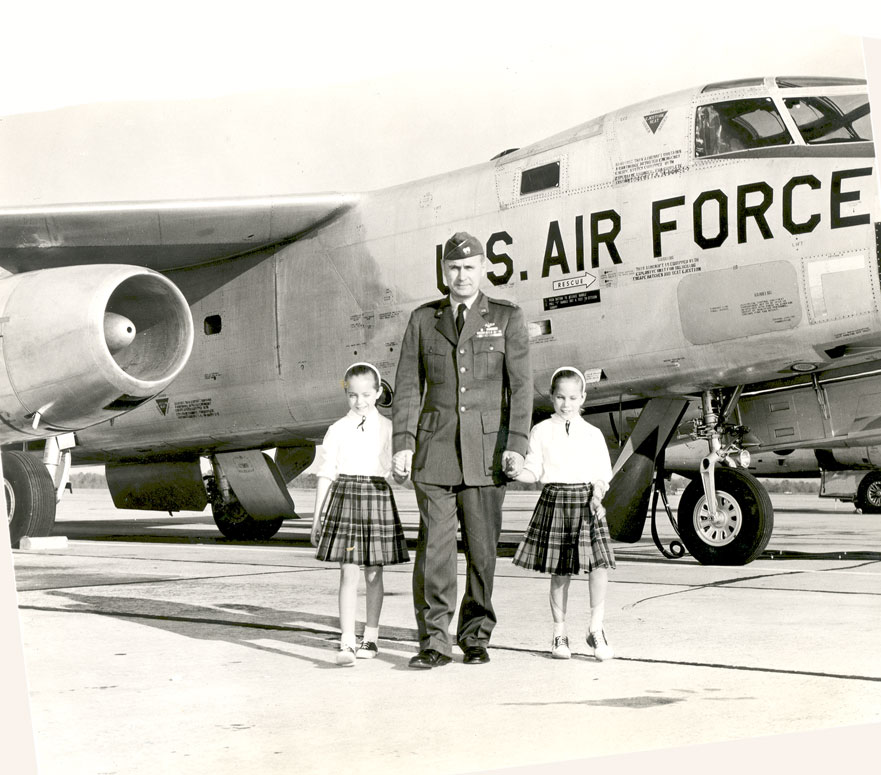 |
|
| Official
USAF Photo, Courtesy of Air Force Weather History Office |
|
|
| From a fact
sheet posted by the
National Museum of the USAF: The WB-66D was a development of the basic RB-66B designed especially for weather reconnaissance and was the first aircraft ever built exclusively as a weather reconnaissance aircraft. All other weather reconnaissance aircraft had been modified from existing aircraft. (Editor's Note: I have a hard time with any claim to "first", "most", "best", etc. Several B-25D's were delivered straight to reconnaissance units in WW II with weather gear installed. The 55th Reconnaissance Squadron (LR) Weather got B-24L and B-24M straight from the factory / mod centers with weather reconnaissance equipment. The B-66 type was certainly not exclusively designed as a weather reconnaissance aircraft. It may be nit-picking, but I would not support this "first aircraft ever built ..." claim. If anyone cares what I think ... ) The mission of the WB-66D included weather intelligence gathering over the battle area as well as traditional weather reconnaissance duties such as storm tracking. A total of 36 WB-66Ds were built with 1955 serial numbers. Deliveries to the USAF began in the summer of 1957. The aircraft carried a crew of five, the most of any B-66 variant, and an extensive assortment of weather data collection instruments that fed raw data into onboard weather analysis computers, giving a complete weather report while in flight. The WB-66D retained the twin 20mm cannon tail turret but carried no offensive bomb load. The bomb bay was used for the extra crewmen and the weather data gathering and analysis equipment. (Editor's Note: Once again, the official "fact sheet" is lacking. While the 5-man crew of the WB-66D was the most of the early B-66 models, it was not the most of "any B-66 variant". That honor goes to the EB-66C, which boasted a crew of seven, including four (4) Electronic Warfare Officers (EWO) in the aft compartment. ) The USAF serial numbers for the 36 aircraft were 55-390 through 55-425, consecutive. SPECIFICATIONS:
The WB-66D saw service with the 9th TRS (TAC) at Shaw beginning in June 1957. By the end of 1957, the aircraft were also on duty with the 67th TRW (PACAF), and the 42nd TRS, of the 10th TRW (USAFE). The WB-66D replaced R/WB-26 and WT-33 aircraft which had been filling the tactical weather reconnaissance misson since the Korean War days. PACAF and USAFE phased out the weather reconnaissance mission in 1960 and removed the WB-66D from their inventory. This drawdown was part of a bigger USAF-wide reduction that also saw major changes in AWS units. The WB-66D stayed in service with the 9th TRS at Shaw until 1965. In USAFE, the WB-66D's of the 42nd TRS were first based at Spangdahlem, GE, and then moved to RAF Chelveston in October of 1959. The B-66 Association has quite a bit of information, primarily about the electronic warfare history of the EB-66 type, including much from the Viet Nam war. Visit their site at: http://www.b66.info Paul Duplessis, the B-66 Association web master, told AWRA about missions using WB-66D's from Shaw AFB that would seem quite familiar to the WC-130 and WC-135 crews that came later on. They used the WB-66D for route reconnaissance ahead of fighter deployments, primarily scouting the air refueling areas for visibility and turbulence - you wanted lots of the former and none of the latter.... The crews of the 53rd, 54th, and 55th WRS called this mission TAC Support or COLD CROSS (later VOLANT CROSS) or just by the various "Coronet" nicknames. In USAFE, the W-66D had a short, but eventful, few years. Initially, they replaced the WT-33 on Wild Goose missions. They would fly a reverse route of planned deployments by USAFE tactical squadrons. Two examples of this found in Doug Gordan's very informative article, "Recce Pukes", were weather reconnaissance tracks in support of the 490th FIS from Erding to Adana, Turkey; and the 32nd FDS from Soesterberg, Netherands, to Wheelus, Libya. In 1958, the weather flight of the 42nd TRS flew numerous missions in support of air and surface movements of the US Task Force deployed for potential operations in Lebanon. The WB-66's were used for a short time as alert force pathfinders for F-100C strike aircraft. This concept had earlier been proven viable during test operations using RB-66 aircraft. This mission was short lived, as the move to Chelveston caused too much separation between the parts of the strike alert force. One last mission in Feb 1960 brought the WB-66D and crews together with their AWS counterparts. Two WB-66 deployed to Wheelus. They provided daily high altitude missions that reported upper level wind information. This was used to improve forecasts for movement of debris from French nuclear tests in Algeria. The WB-66 data was very helpful to both the WB-50D and RB-57 atmospheric samplers. We would love to hear from any veterans of the WB-66D program to tell us how else the system was operationally employed. Contact us at: awra038@aol.com |
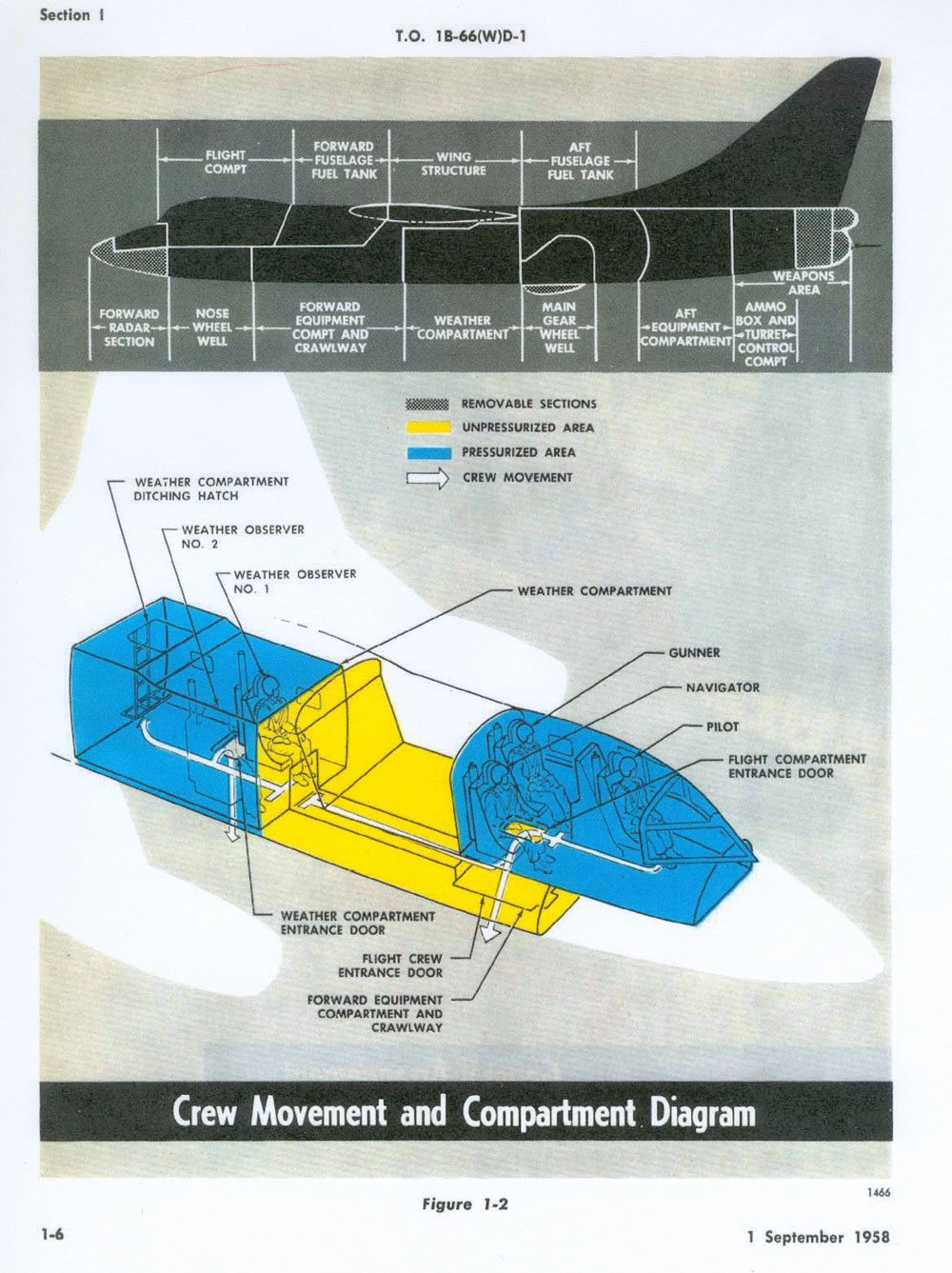 |
Diagrams from the WB-66D Flight Manual show the location of the two-man weather compartment where the bomb bay had been. Also note the 5 person crew, including a single pilot, navigator, and gunner, as well as the 2 weathermen. |
| The
weather reconnissance equipment in the WB-66D was very similar to the
WB-50D, that was in development at the same time for Air Weather
Service. The weather officers had an SCR-718-E radar altimeter to
measure the height above the surface (land or water), as well as
repeater readouts of the N-1 compass, outside temperature, pressure
altitude, and the AN/APN-82 Navigation system. The AN/APN-82
combined an AN/APN-81 doppler radar with an AN/ASN-6 to provide a
latitude and longitude position. Additional AN/APN-82 readouts
included wind speed and direction. The weather observers did not have a repeater scope nor access to the navigators AN/APS-63 search radar. There was no way for the crew to move between the two pressurized sections of the plane. The navigator did have an O-15 camera to record images from the radar for post mission analysis. Another weather reconnaissance system was a pair of P-220 sequential weather cameras located on the forward fuselage access doors on the right and left side of the fuselage. The optical axis these two cameras was 90° to the line of flight and 21° down. They were controlled from the No. 1 weather position and could be set to take images at intervals between 1 and 60 seconds apart. |
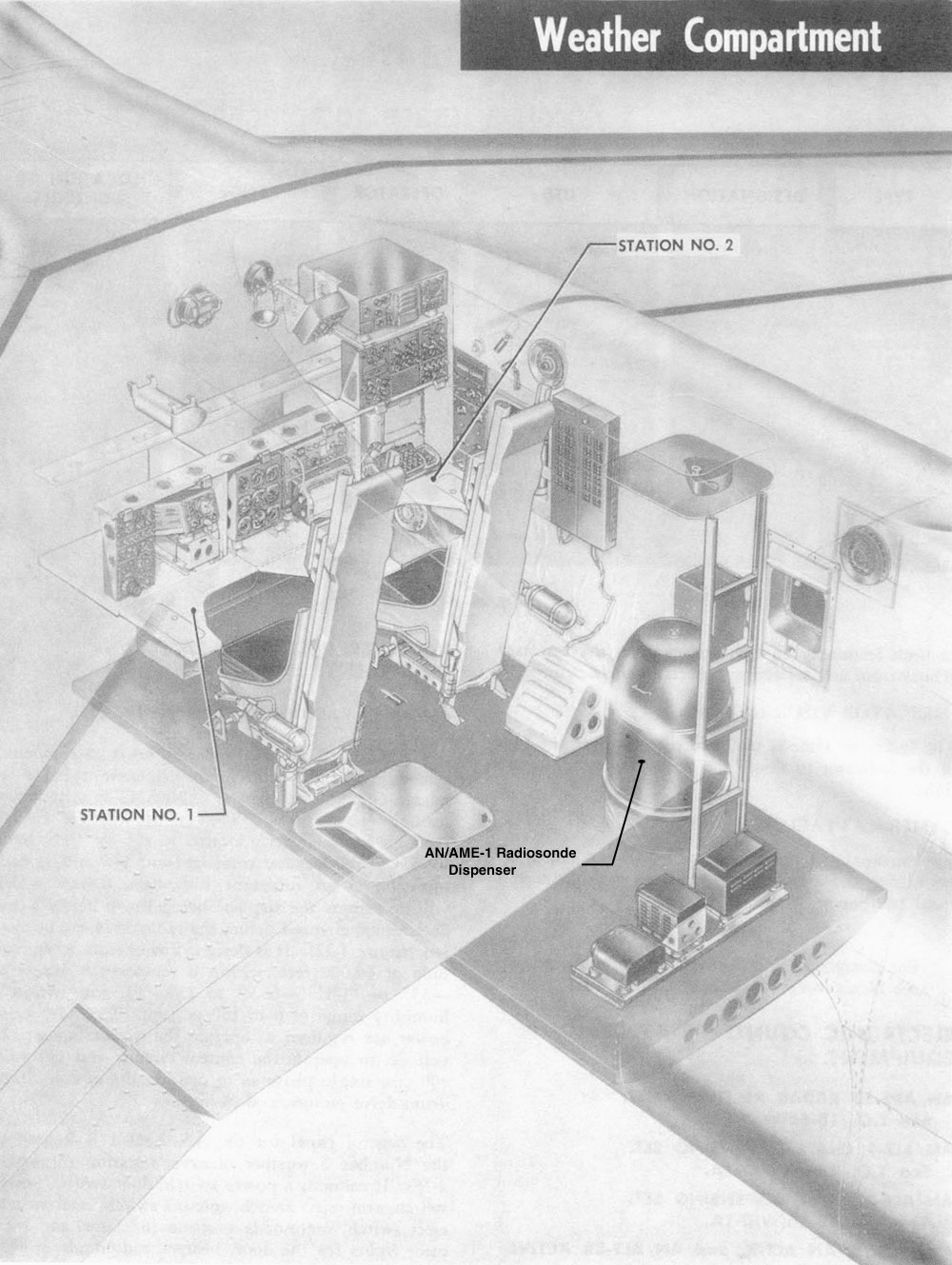 |
Another illustration from the WB-66D Flight Manual shows the layout of the weather compartment inluding the Radiosonde (Dropsonde) Dispenser that could launch up to 8 AN/AMT-6 radiosondes without reloading. |
| The
No. 2 weather position in the WB-66D controlled the Radiosonde (or
Dropsonde) system which consisted of an AN/AME-1 Dispenser, and an
AN/AMR-3 Radiosonde receptor. The AN/AME-1 could be preloaded
with up to 8 AN/AMT-6 Radiosondes. It was possible to reload the
dispenser in flight, but the weather compartment had to be
depressurized. The No. 2 position also had the TT-76/GGC
Teletypewriter. |
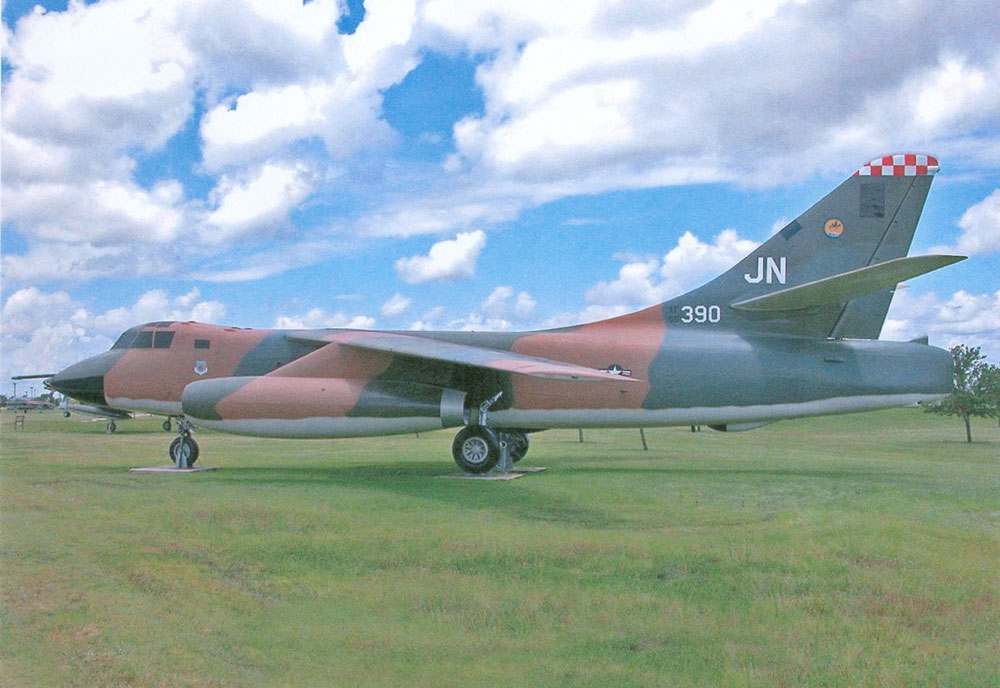 |
|
|
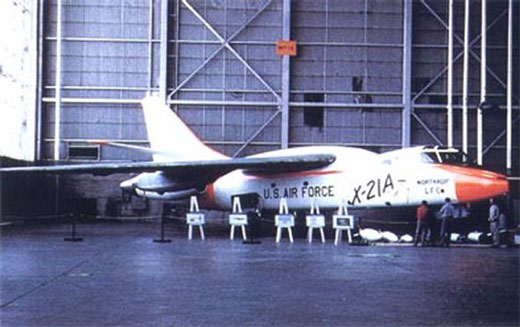 |
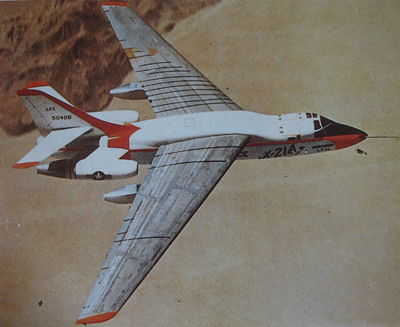 |
|
| Official
USAF Photo, Courtesy of globalsecurity.org |
||
|
||
Return to the Top of the Page